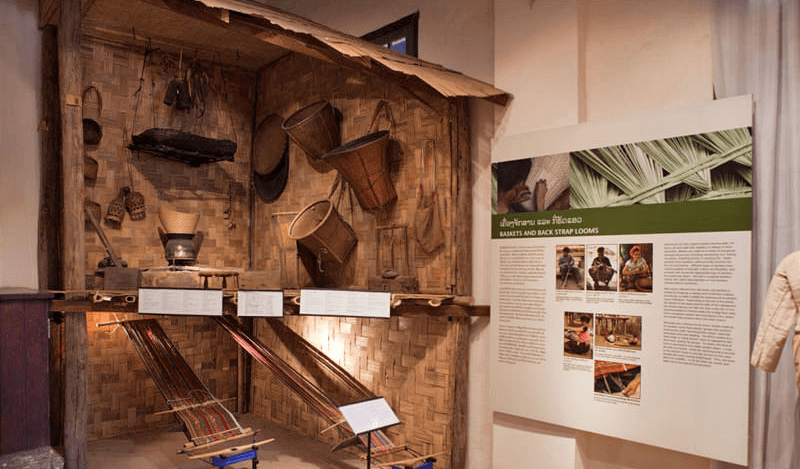Royal Palace Museum in Laos
Royal Palace is located on Mekong riverside and faces Mount Phousi. The residence of the Laos Royal family was turned into the National Museum after the royals were forced to leave the palace. It is a combination between French Beaux Arts and Lao traditional style. At the main entrance is a depiction of the 3-head elephant ridden by the Hindu God Indra. The golden elephant is surrounded by mythological Naga snakes and a royal symbol of White Parasol.
The main entrance of Royal Palace Museum in Laos
A variety of Buddha images are present at the entrance hall. Behind the entrance hall is the King’s former reception room where contains 3 statues of the last Lao Kings and pictures of daily life in Luang Prabang during the early 20th century on the walls. Besides, the Queen’s displays visitors’ gifts.
A statue of the Lao King at Royal Palace Museum
Furthermore, the center of the area is Throne Room decorated with a Lao style spire, red walls and glass mosaics. The room contains some ancient gold, crystal Buddha images from the 15th and 16th centuries. Additionally, Phra Bang, the most sacred Buddha statue of Laos is placed in a stunning shrine in a corner of the Palace grounds. The private quarters of the Royal Family such as bedrooms, dining room and library still keep the original furniture.
Throne room at Royal Palace Museum in Laos
Lao National History Museum
To have more details of people, culture and history of Laos, Lao National History Museum or Lao National Museum in the capital of Vientiane is an ideal choice. Originally, the building was called the Lao Revolutionary Museum because of stress on struggle for independence and communism. The structure consists of a large number of items from prehistoric times to the present day. The ground floor exhibits ancient pieces of the early regional history such as dinosaur bones, stone tools, pottery fragments, rock paintings, Khmer sculptures and Buddha statues.
A painting at Lao National History Museum in Laos
Upstairs, you will find information related to the Lao modern history from the Siamese invasions and the French colonial period to the modern day. There are some photographs of old prisons, soldiers, the Secret War and a reminder of the difficulties the country faced during the colonisation. There is a shrine to Kaysone Phomvihane, the first Prime Minister of Lao PDR. All his personal items including a spoon he once used are displayed here.
Upstairs at Lao National History Museum
Lao People’s Army History Museum
This museum established in 1976 is located near the Ministry of Defense on Kaisone Phomvihane Road in Vientiane. The building is a fantastic display of artifacts such as weapons, tools, and photos of the Lao People’s Army from the revolutionary period in 1950 to the independence in 1975. Get into the area, the first items you see is various kinds of troop vehicles and war planes that were used in the wars.

Planes at Lao People's Army History Museum in Laos
Next, visitor can see a short documentary about key historical events of Laos. Beside statues of Lao leaders, heroes and other important people in Lao history, there are many sculptures describing the revolutionary struggle of the workers. Moreover, a variety of stories of the Lao soldiers and people served in Lao armies are told in the gallery. The information about the Lao People’s Army such as birthplace, history, growth and battles against foreign incursions also are uncovered here.

Inside Lao People's Army History Museum
The Savannakhet Dinosaur Museum
This building is situated at Kaysone Phomvihanh Town in Savannakhet city. In the hall, tourists can find a huge collection of dinosaur fossils called big lizard bones in Lao. They were excavated from 1930 to the present. Dinosaur bones here are divided into three kinds: Pode, Iguanodon and Sauropode. Even the museum keeps some spiecies of a meteorite falling to the earth over 100 million years ago. Furthermore, early mammalian existing about 200 million years ago and rare stones are also on displays in the museum.

The Savannakhet Dinosaur Museum in Laos

The Savannakhet Dinosaur Museum
Traditional Arts and Ethnology Centre (TAEC)
The centre in Luang Prabang founded in 2016 is the only non-profit museum in Laos with the aim to collect, interpret and preserve the lives of the country’s ethnic groups. Inside the museum contains traditional textiles and clothing, jewellery, religious artefacts, handicraft tools, baskets and household objects. Travellers will have a deeper understanding to a very diverse ethnic population, the life of people and varied culture of Laos with display of arts, quotes, photos and videos. There is a heavy emphasis on 4 ethnic groups including Akha with the diversity of ethnical groups; Hmong with their New Year festivities; Tai Lue with their cotton industry, from plantations to clothes and Khmu with their baskets and Back Strap Looms. The museum shop give local craftsmen and women with a chance to sell their hand-made goods. Beside, the centre has a small library and the TAEC coffee serving visitors.
Traditional Arts and Ethnology Centre
Traditional Arts and Ethnology Centre
COPE Centre
A statue at the entrance was made from 500kg of metal from bomb casings and other ordinance and is dedicated to all those who were injured, lost lives and lovers. When getting into the centre, tourists will see bombies dangling from the ceiling. Additionally, the problems of UXO in Laos are also displayed in an exhibition. You can watch several documentaries films about the history of the bombings in Laos like Bomb Harvest, Bombies, Deadly Harvest in the movie room. For pieces of destroyed munitions, Laotians recycled to create items such as cooking pots, knives and rice cookers. Moreover, COPE workshop will help travellers know how to make polypropylene prosthetic legs. Karma Cafe and gift shop here are built from local bamboo. Their proceeds will be added to the fund of the project.
The entrance at COPE Centre in Laos
COPE Centre












